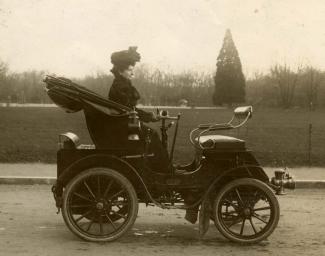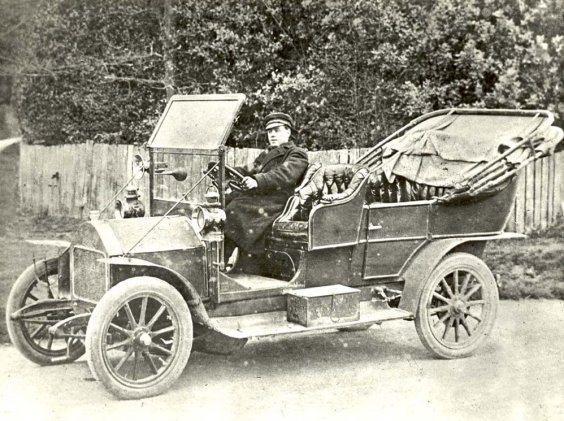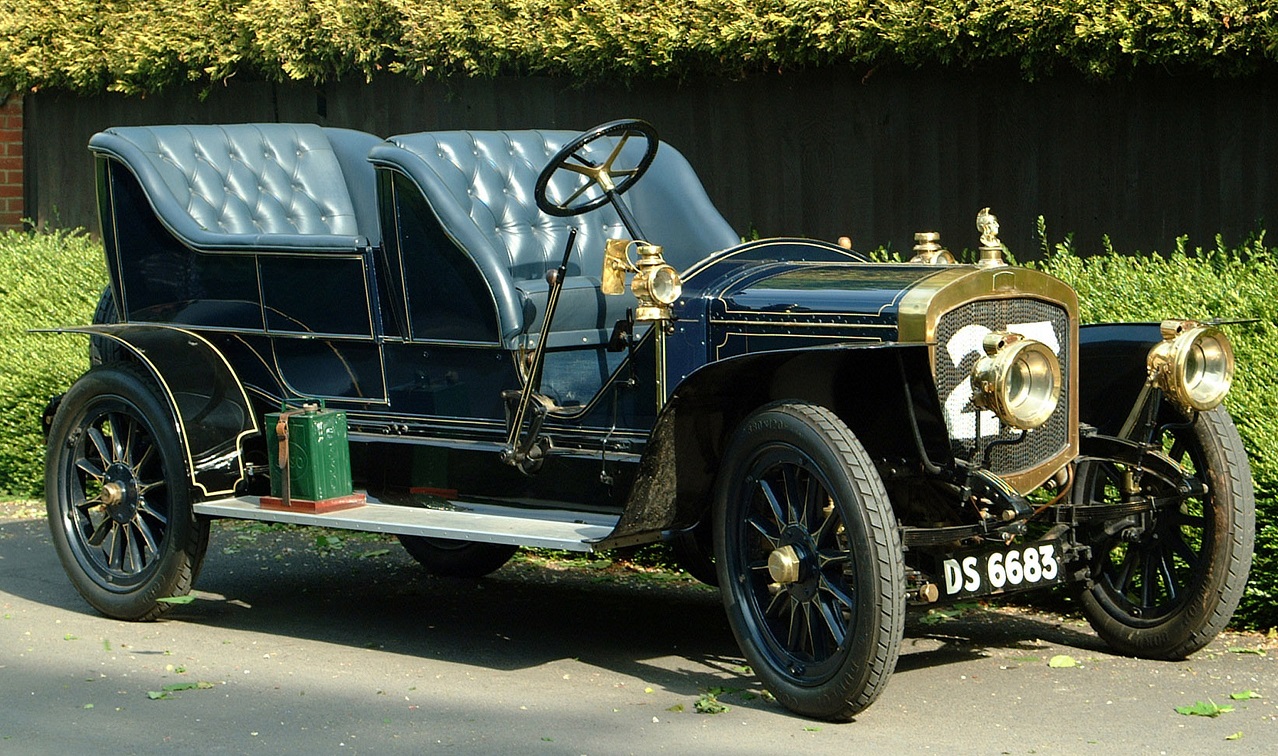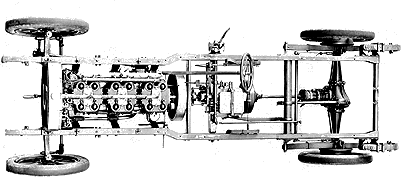
Cars 1903-1912
Thornycroft manufactured cars between 1903 and 1912. In the early part of this period, British cars sometimes used major items and components of foreign origin, but Thornycroft shunned this approach and designed and built its cars almost entirely, including carburettors, at its Basingstoke factory. During Thornycroft’s car-building era, and for some years thereafter, it was normal for customers of upmarket cars to buy their cars as bare chassis and to have the bodies built and installed by coachwork specialists. Thornycroft sold bare chassis to those who wanted them, but, in keeping with its policy of building as much as possible at Basingstoke, Thornycroft also offered complete cars with standard bodies ready installed. Naturally, complete cars cost more than bare chassis, and the price of a complete car from Thornycroft depended on the bodywork specified, of which there were standard options: e.g. Victoria Body, Single Landaulette, Double Landaulette, Limousine and Roi-des-Belges, etc, depending on year. Also, in those more bespoke days, Thornycroft offered to quote for other types of body to suit customers' individual requirements.
Thornycroft claimed that British cars, while initially inferior to imports, had become as good as any from overseas. The firm tried to help car buyers by proposing criteria which they should consider when deciding on the make of car to buy, from the wide choice of British and foreign cars available. Thornycroft pointed out that, at the time of writing, there was no longer any reason to buy foreign because the best makes of British car had "regained the lead" which foreign makes once held, and advised that a 20-25hp car would prove "most satisfactory" for carrying four or five people in comfort, with enough power "to climb all hills… that may be met on ordinary roads". This engaging concern about hill-climbing ability was typical of the time. The reader was also treated to a comparison between chain and prop shaft drive, with the argument coming out in favour of the prop shaft which, of course, was a Thornycroft feature!
Reflecting the more primitive nature of motoring nearly a century ago, Thornycroft supplied very comprehensive tool/spares kits as standard with their cars, which hinted at the problems faced by contemporary motorists. For instance, in 1907 Thornycroft supplied each car with a comprehensive set of spanners, four interchangeable exhaust and inlet valves, two sparking plugs or insulated contact pieces, two side lamps, one tail lamp, one horn, one jack, one oil feeder, one hand hammer, one screw-driver, one pair of cutting pliers, one inflator, two tyre levers, one repair outfit for tyres, an assortment of nuts, bolts and split pins, etc, one pound of cotton waste, one yard of copper wire, two sheets of emery cloth and one pound of grease!
Thornycroft stopped car production in 1912 to concentrate resources on producing its best-selling commercial and other heavy vehicles. This website gives a timeline history of the Thornycroft company’s car-building activities during the period 1903 to 1912, and reproduces some testimonials from satisfied customers.
Information for these pages comes from contemporary Thornycroft data sources, as well as contemporary copies of The Car, The Automotor Journal, The Autocar and The Motor.
Good publicity
Manufacturers then, as now, jealously guarded their reputation for quality and reliability and took every opportunity to laud their products. Testimonials from satisfied customers made excellent publicity, and some of them were reproduced in publicity material. For example, Viscount Halifax, writing about his car, said that "….both in respect of its running powers and also of its comfort, it has given me the most complete satisfaction".
A M S Methuen, of Haslemere, Surrey, said that "….the whole car runs with a noiseless smoothness which is most welcome….".
Other testimonials mention Thornycroft cars' reliability, silence, and smooth running. Indeed, there is a theme of operating refinement permeating comments about Thornycroft cars.
Thornycroft also reproduced press opinions, and the Autocar journal made a delightful comment "...particular quietitude and sweetness of running qualities…". Motor World judged Thornycroft cars to "….rank with the foremost of British manufactured vehicles", while the Automotor Journal wrote that "…they are cars which will maintain the reputation of this firm of well-known engineers".
Model Range 1903-1904

By the early part of the last century it was evident that private cars were here to stay, and numerous firms were attracted into motor manufacturing to exploit the growing market. One such firm was the Thornycroft Steam Wagon Company Ltd, which entered the fray in 1903. Thornycroft's first petrol models were a twin-cylinder 1,788cc car known as the 10hp, and the 3,576cc four-cylinder 20hp. Both cars had water-cooled in-line engines, with splash lubrication, and cylinders for the 10hp car were cast as a pair in a single block, in which the water jacket, cylinders and cylinder heads were cast in one piece. The engine for the 20hp "four" was simply a doubled-up 10hp unit, comprising two separate twin-cylinder blocks. There were two valves per cylinder of ioe layout, and a point of interest was the automatic overhead inlet valves used on both 10hp and 20hp cars, which were opened by atmospheric pressure during the induction stroke; although long since discarded, automatic inlet valves were not uncommon in the very early days of motoring. Both cars had camshaft-operated side exhaust valves.
Power was transmitted to a differential mounted on the back axle, through an expanding clutch with cylindrical pressure surfaces, a three-speed gear box with reverse and direct-drive top, and a propeller shaft supported on a universal joint at each end. This power train layout became almost universal in cars for about 50 years until transverse engines and front-wheel drive became widespread, but in 1903 chain drive was not uncommon. The differential was braced by a radius rod to the gearbox. The expanding clutch was replaced with a metal-to-metal plate type for 1904.
Thornycroft followed convention by not fitting brakes to the front wheels of its cars, a feature which should be seen in the light of lower traffic densities and speeds in the early days of motoring - e.g. 30 to 40mph (48 to 64kph). Braking was achieved with brakes on the rear wheels and a transmission brake, an arrangement which was used on all Thornycroft cars.
Wooden artillery-style wheels were fitted to beam axles fore and aft, suspended by semi-elliptic springs. Spark ignition was fitted, with one spark plug per cylinder. Ignition on both cars was by HT coils, supplied on the LT side by a battery through a distributor. On the 10hp, at least, the two HT coils were trembler devices. The battery for energising the HT coils was charged by a dynamo, belt-driven from a pulley mounted on a crankshaft extension behind the engine.
Thornycroft's first car sale was vehicle no. 199, a 10hp which went to J Dent on 29 June 1903. Although the 20hp was introduced in 1903, Thornycroft had to wait until 18 June 1904 to sell the first one, when vehicle no. 350, a side entrance car, was bought by A. Blackburn. This was nearly 18 months after the 10 and 20hp cars were first shown at the 1903 Crystal Palace Automobile Show. Both the 10hp and 20hp cars were continued for 1904, the only types produced that year.
Model Range 1905
Thornycroft discontinued the 10hp for 1905 and introduced two new cars, both powered by water-cooled, in-line "fours", the 4,650cc 24hp and the 2,715cc 14hp; the latter had an advanced sohc engine with a five-bearing crankshaft.
The 14hp car was built for the Isle of Man TT Race and was introduced during the summer, so it may not have been intended for sale to the public. Two 14hp cars were entered for the 1905 TT Race; car no. 12 was entered by Tom Thornycroft and no. 47 was entered by G V Baxendale, but there were no wins for Thornycroft that year.
Surprisingly, the normal speed of the 14hp's sophisticated engine was only 900 rpm, less than the 1,000 rpm of the more prosaic 24hp car with its simple T-head engine. Ignition on both 14hp and 24hp cars was by LT magneto, in which, remarkably, make and break took place inside the cylinder! Although crude by modern standards, LT ignition was commonly used at the time.
Both 14hp and 24hp had forced lubrication by an engine-driven pump - a major improvement over earlier cars' splash lubrication.
Thornycroft regarded an order for a 24hp Double Landaulette from HRH Princess Christian of Schleswig-Holstein as a publicity coup. Princess Christian, one of Queen Victoria's daughters and formerly Princess Helena before her marriage to Prince Christian, took delivery of her car in 1905. The Thornycroft sales register records that the only 24hp Double Landaulette delivered in 1905 went to a J Hegel on 18 September as vehicle no. 512. This may have been Princess Christian's car, in which case J Hegel would have been an agent accepting the car on her behalf.
Model Range 1906
The 20hp car was discontinued for 1906 and cars listed for the year comprised the 24hp introduced the previous year, the magnificent new six-cylinder 6,975cc 36hp and the 14hp with its advanced sohc engine (updated with HT coil ignition instead of the previous year's LT magneto).
Tom Thornycroft drove a 14hp in the 1906 TT, but the car suffered from technical problems.
Like its 24hp stablemate, the 36hp car had T-heads, and cylinders cast individually. Specific power outputs were very low in the early part of the last century, and the six-cylinder car's meagre 36bhp from nearly seven litres now seems almost unbelievable!
Thornycroft traded on its marine engineering reputation when it introduced its six-cylinder car, claiming, probably rightly, that its experience of building six-cylinder marine engines underwrote the design of the new automotive "six". Also, Thornycroft thought it useful to remind car buyers of the firm's wider technical competence, mainly in marine engineering, e.g. war vessels, shallow draft vessels, yachts, motor launches, steam wagons, petrol wagons, passenger vehicles, steam engines, marine motors, generator sets for lighting, water tube boilers, marine propellers, and other products. Modern-day experts would probably dismiss the relevance of some of Thornycroft's other activities, by claiming that there was no "synergy" between cars and marine engineering! In this, the experts would almost certainly be wrong.
HRH Princess Christian was evidently well pleased with her 1905 Thornycroft car, because the firm's 1906 brochure, Thornycroft Touring Cars, proudly proclaimed that "As a special mark of appreciation of the excellent running qualities of the Thornycroft car supplied to their order, Their Royal Highnesses Prince and Princess Christian of Schleswig-Holstein have been graciously pleased to favour us with a Royal Warrant of appointment as motor manufacturers". Princess Christian took delivery of a 1907 30hp Limousine on 26 November 1906 as vehicle no. 643. This is the only delivery against which Princess Christian is mentioned in the Thornycroft sales register, and any other cars supplied to her were presumably accepted on her behalf by agents, whose names would be in the register.
The 24hp car and, possibly, the 36hp in the 1906 model line-up were fitted with LT ignition, but the 14hp car's HT coil system was the shape of things to come. However, for about the next 25 years, vehicle manucturers became wedded to the HT magneto, which had the advantage of being a compact, self-contained spark generator with a built-in make-and-break and distributor. By the mid-twenties about 65 per cent of cars in the UK had magneto ignition. However, coil ignition eventually won the day on, and the HT magneto is now all but extinct on cars.
Model Range 1907-1908
Thornycroft continued with its 1906 models for 1907, with the exception of the 4,650cc 24hp, which was replaced by the 5,213cc 30hp, another large "four" with the, by now, well-tried in-line, T-head layout. The 30hp car retained the LT ignition system of its 24hp predecessor. Thornycroft entered two cars for the 1907 Isle of Man TT Race, a 14hp with improvements following the previous year's technical problems, and a 30hp in the heavy car event. The 14hp reportedly ran well during pre-race trials round the course, but not much is known of the car's showing during the race. The 30hp car ran out of petrol during the heavy car race, and the rules prevented replenishment.

1908
Offices and showrooms were opened in Albemarle Street in London's West End, to tap into the wealthy London society market. Not satisfied with 6,975cc, Thornycroft enlarged its big "six" by nearly a litre for 1908, to a massive 7,819cc, and introduced the car as the 45hp.
This enormous engine gave around 45bhp at 1,000rpm and, like all other Thornycroft car engines, was an in-line water-cooled engine. The 45hp had a four-bearing crankshaft and unlike the 36hp, its cylinders were cast in pairs, with a noticeable gap between each pair to allow for the two intermediate main bearings.

Other cars for 1908 comprised the 30hp, continued from the previous year, and the new 18hp which was an improved 14hp with the same 2,715cc capacity. Perhaps the most interesting 1908 cars were the three four-inch racing cars built to compete in the TT Race. Two of the four-inch cars had three-speed gearboxes with direct-drive top, while the other a four-speed all-indirect box. Tom Thornycroft's car came fifth in the TT at 44.1mph (71kph). Much bigger than the 14hp cars entered for previous TT events, the four-inch cars' 4,119cc four-cylinder engines gave 46bhp at 2,000rpm - about double the rpm of Thornycroft's touring cars, so the four-inchers were highly tuned in comparison.
From this year on, all Thornycroft cars had HT ignition.
Model Range 1909-1912
For this year, the company's three-car range included the 18hp, 30hp and 45hp. However the 1909 18hp was radically different to its 1908 predecessor, and less sophisticated, with a simple monobloc L-head replacing the sohc; however, like its predecessor, the 18hp had a five-bearing crankshaft. Surprisingly, in a seemingly retrograde step, the 18hp car had thermo-syphon cooling water circulation instead of a water pump. However the five-bearing crank allowed enough water space between cylinders for thermo-syphon to give adequate cooling. A four-cylinder 3,258cc engine, the new version of the 18hp engine was larger than its 2,715cc predecessor. From this year forward, all Thornycroft cars had side valves, either L-head or T-head.
1910 and 1911
The 1909 range was continued for both 1910 and 1911, but the 18hp was enlarged, yet again, from 3,258cc to 3,707cc for 1911. The London showrooms in Albemarle Street were closed in 1910.
1912
Thornycroft discontinued the big 45hp six-cylinder cars for this year, and retained the 18hp and 30hp cars. This was the last year of Thornycroft car production, because demand for the firm's commercial vehicles was high enough to justify turning car manufacturing facilities over to commercial vehicle production. A relatively small total of about 270 cars were delivered during nine years of production.



